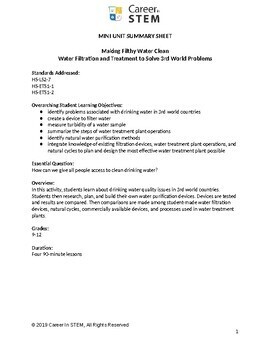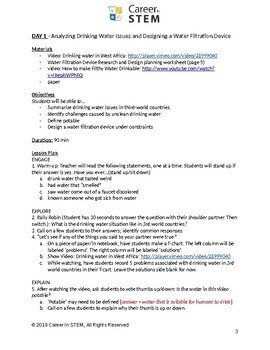Engineering Mini Unit & Project Based Assessment: Water Pollution STEM Challenge
- PDF
What educators are saying
Also included in
- A solid understanding of Environmental Science is critical for our next generation of leaders and innovators. Combine scientific understanding with career exploration in this Environmental Science STEM Lessons and Career Exploration Bundle! A good mix of in person and distance learning resources incPrice $36.41Original Price $40.46Save $4.05
Description
Did you know that 1.6 million people die annually from unclean drinking water? In this mini-unit, students work to solve this world health crisis using STEM concepts of water filtration and treatment. Students first learn about the severity of drinking water quality issues in 3rd world countries. They then research, plan, and build their own water purification devices. Devices are tested and results are compared (using turbidity meters). Then comparisons are made among student-made water filtration devices, natural cycles, commercially available devices, and processes used in water treatment plants. Students then participate in a project-based assessment to integrate the knowledge of existing filtration devices, water treatment plant operations, and natural cycles to plan and design the most effective water treatment plant possible.
This mini-unit is directly aligned with the following NGSS Standards:
HS-LS2-7
HS-ETS1-1
HS-ETS1-2
Overarching Student Learning Objectives:
- identify problems associated with drinking water in 3rd world countries
- create a device to filter water
- measure the turbidity of a water sample and analyze results
- summarize the steps of water treatment plant operations
- identify natural water purification methods
- integrate the knowledge of existing filtration devices, water treatment plant operations, and natural cycles to plan and design the most effective water treatment plant possible
Mini-Unit Essential Question:
How can we give all people access to clean drinking water?
Duration:
Four 90 minute lessons
Purchase Includes:
- unit overview (1 page)
- full unit materials list (1 page)
- four 90-minute in-person lesson plans in 5E format; also includes links to online resources, rubrics, and student worksheets (15 page PDF document)
This is a comprehensive mini-unit with all required materials - zero prep! Additionally, the download comes as an editable Word document enabling you to customize rubrics and/or student worksheets as desired.
This resource works best with in-person learning.
More Engineering STEM Career Exploration Resources
- Biomedical Engineer Lesson Plan
- Engineering Careers Webquest
- Automotive Engineer Challenge
- Intro to Mechanical Engineering STEM Challenge
- Construction Safety Charades Game Slideshow
- Intro to Engineering Career Exploration
- Intro to Civil Engineering STEM Challenge
- and many more engineering STEM activities!
Want valuable download & go resources to help you effortlessly integrate STEM career exploration? Then get a copy of my FREE Quick Start STEM Career Exploration Kit!






